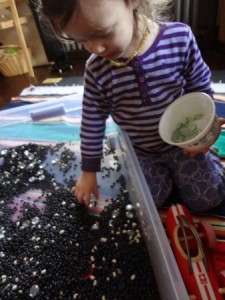Tips for Encouraging Independent Play with Toddlers
How can I encourage my son to play independently more often?
A simple question asked by a mama friend, but it sparked so many thoughts. I’m on this tandem nurturing journey, too, so I can only share what I’ve experienced. Of course, what works for me won’t necessarily work for others. Regardless of the various situations people can find themselves in and despite my lack of credentials, here’s my two cents on independent play:
To be clear: I believe children can play independently through their own direction without special “tasks” or “toys,” but I think a mama/caregiver who needs a few minutes can get her needs met with well-designed activity.
When training to be a reading specialist, a professor told me that an activity is good for a child if they can feel both challenged and successful. In this instance, the caregiver also needs the child to be independent and safe. The following are a few things to consider when designing activities to meet these goals.
1. Choose an activity that is developmentally appropriate for and of some interest to the child.
Developmental stages come with their own interests that can be used as a foundation. For instance, toddlers are working on understanding open and close as well as pouring and dumping. Stirring (mixing) and sorting, tearing and toppling are also stimulating to many toddlers. (Notice these are physical activities as opposed to reading a book.) These will be probably be favorite activities and have the potential to hold a child’s focus as they learn through play. Some children will also exhibit a strong interest in or knowledge of a particular topic. This background can be used to create a theme for an activity, such as a sensory bin, or could be helpful if they are trying something for the first time or need an extra boost.
2. Consider your own mental and emotional attitude when choosing materials.
This seems silly but is actually pretty important in my estimation. Some folks just lose it if a mess is made, whereas others just don’t feel so triggered by a mess. I believe the more mess that a parent can tolerate the better off their child probably is, within reason. This is because children are learning everything for the first time, and exploratory research is most effective when done freely and creatively. This means a messy process. So, my point is, if you are feeling short-tempered one day, get out the dot markers instead of the finger paints, use beans instead of water. Same activity/idea with sanity-maintaining materials…
3. Create an appropriate amount and type of space to do what is necessary along with a helpful amount of containment to keep the mess to a sane level.
Again, that’s mama’s sanity I’m talking about because children would probably learn a great deal by painting on every surface available. I put an old coffee table in my daughter’s playroom so she would have a big enough space to finger paint and create. This allows me to say to her that the paint stays on the paper, knowing she has some good space to move. I also add that she needs to stay on the mat (a tarp) I laid down under the table that covers a wider space, again so she feels freedom but has limits that feel good to me also. [Note: Most adult intervention will probably be around defining use of space in the form of reminders. “Paint goes on the paper.” See post on discipline resources for helpful suggestions for setting limits in a loving, respectful and effective way.]
4. Encourage confidence, creativity, and curiosity when you do play together with your child.
Confidence, creativity and curiosity will help a child play independently even through moments of frustration. Going along with your child’s imaginary play and game ideas can build confidence. Generate play possibilities for later independent play while encouraging your child’s creativity with open-ended statements and questions such as “I wonder where the ducks are going,” or “What should we do with the stick?” Model curiosity and independent play by actually getting into your own games and adventures. I love what Janet Lansbury has to say about playing in a way that allows for a child to feel that “I did it” feeling. The more a child feels like they can do, the less they need you to do, including play. Balancing times where you are a fully engaged participant with times where you are a quieter observer will make the jump to independent play more natural.
5. Talk with your child about feelings, especially frustration.
I wrote a post on feelings about my own experiences talking with my daughter, particularly around frustration. I believe that this talk and the breathing we often do together has led her to be able to take a moment to gather herself and try once again. Sometimes she will ask me for help out of clear frustration, and I might say “You seem frustrated. It is hard to pick up the bike by yourself. If you need to you can take a breath and try again or take a break.” This allows me to find out if she really needs my help physically or if it’s more emotional help that she is needing to keep playing. It also communicates to her that I am confident she can handle the task. The more she can try again independently, the more chances she has to explore, be creative and problem solve….all independently.
……
Again, I’m working on these things, too, but I hope these tips help others. I have found that with these things in mind I can design an activity that my child loves and can play with independently. This has been particularly helpful these last few weeks because I can breastfeed baby or get a meal going with minimal supervision.
Sometimes, though, I find myself just sitting and watching her play even when I have goals to do other things, just because watching a child play is fascinating, inspiring and beautiful…. especially when it’s you’re own child!
****************************************************
RESOURCES
- My Plan to Be a Better Mom: Activities (my own post with a ton of links to other folks doing awesome activities with children)
- 15 Indoor Activities to Keep Your Toddler Occupied This Winter
- 25 Things to Do with a Wiggly Toddler Boy
- Ideas for Toddler/Preschool Activity Bags
Activities I Have Tried
- Open and Close — clean, anywhere activity that required no real supervision
- Sensory Bin of Beans and Buttons — required some supervision in form of reminders, especially the second time when I added new items
- Sound Shakers — not such a hit with my daughter…yet?
- Water in a bin or bucket + some spoons and a little bowl or glass (recommend towels at the ready and/or on the floor)–requires half an eye on things
- Scoop and Pour (beans, nuts, buttons, whatever!) — required almost no supervision
- Play Dough (“making pie”) — winner, almost every time, especially if you add a rolling pin, spoon, knife, fork, bowl or other fun utensil — someone made my daughter some, but here are 3 recipes





these are fantastic ideas! thanks!
There are so many ideas for general support, Misty, but these were helpful for me when I really needed some help with two.